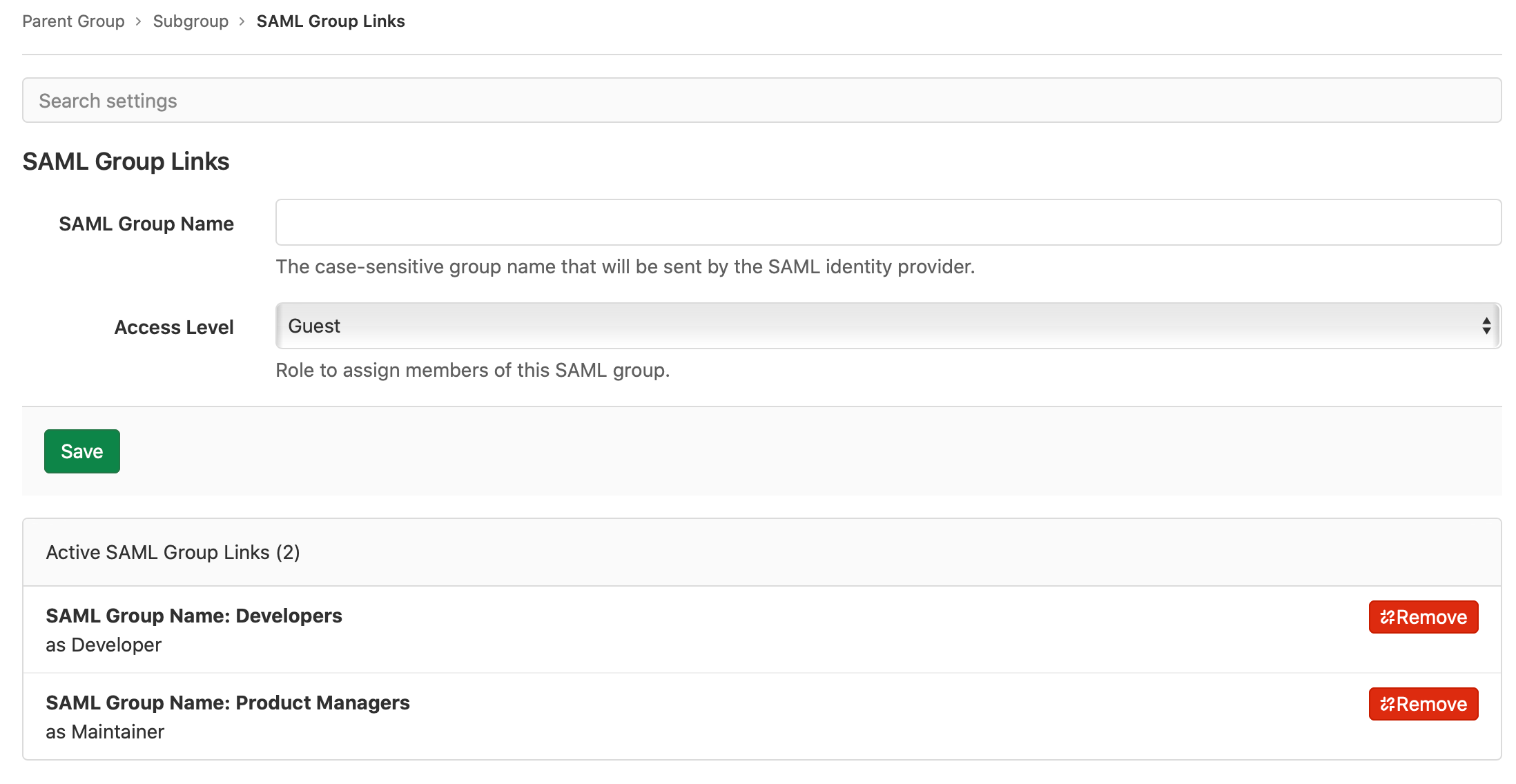SAML Group Sync (PREMIUM)
Introduced for self-managed instances in GitLab 15.1.
WARNING:
Changing Group Sync configuration can remove users from the mapped GitLab group.
Removal happens if there is any mismatch between the group names and the list of groups in the SAML response.
If changes must be made, ensure either the SAML response includes the groups attribute
and the AttributeValue value matches the SAML Group Name in GitLab,
or that all groups are removed from GitLab to disable Group Sync.
For a demo of Group Sync using Azure, see Demo: SAML Group Sync.
Configure SAML Group Sync
To configure SAML Group Sync:
- For GitLab self-managed:
- Configure the SAML OmniAuth Provider.
- Ensure your SAML identity provider sends an attribute statement with the same name as the value of the
groups_attributesetting.
- For GitLab.com:
- See SAML SSO for GitLab.com groups.
- Ensure your SAML identity provider sends an attribute statement named
Groupsorgroups.
NOTE:
The value for Groups or groups in the SAML response can be either the group name or the group ID.
<saml:AttributeStatement>
<saml:Attribute Name="Groups">
<saml:AttributeValue xsi:type="xs:string">Developers</saml:AttributeValue>
<saml:AttributeValue xsi:type="xs:string">Product Managers</saml:AttributeValue>
</saml:Attribute>
</saml:AttributeStatement>Other attribute names such as http://schemas.microsoft.com/ws/2008/06/identity/claims/groups
are not accepted as a source of groups.
See examples
for configuring the required attribute name in the SAML identity provider's settings.
Configure SAML Group Links
When SAML is enabled, users with the Maintainer or Owner role see a new menu item in group Settings > SAML Group Links. You can configure one or more SAML Group Links to map a SAML identity provider group name to a GitLab role. This can be done for a top-level group or any subgroup.
To link the SAML groups:
- In SAML Group Name, enter the value of the relevant
saml:AttributeValue. - Choose the role in Access Level.
- Select Save.
- Repeat to add additional group links if required.
If a user is a member of multiple SAML groups mapped to the same GitLab group, the user gets the highest role from the groups. For example, if one group is linked as Guest and another Maintainer, a user in both groups gets the Maintainer role.
Users granted:
- A higher role with Group Sync are displayed as having direct membership of the group.
- A lower or the same role with Group Sync are displayed as having inherited membership of the group.
Automatic member removal
After a group sync, for GitLab subgroups, users who are not members of a mapped SAML group are removed from the group.
FLAG:
In GitLab 15.1 and later, on GitLab.com, users in the top-level
group are assigned the default membership role rather than removed. This setting is enabled with the
saml_group_sync_retain_default_membership feature flag and can be configured by GitLab.com administrators only.
For example, in the following diagram:
- Alex Garcia signs into GitLab and is removed from GitLab Group C because they don't belong to SAML Group C.
- Sidney Jones belongs to SAML Group C, but is not added to GitLab Group C because they have not yet signed in.
graph TB
subgraph SAML users
SAMLUserA[Sidney Jones]
SAMLUserB[Zhang Wei]
SAMLUserC[Alex Garcia]
SAMLUserD[Charlie Smith]
end
subgraph SAML groups
SAMLGroupA["Group A"] --> SAMLGroupB["Group B"]
SAMLGroupA --> SAMLGroupC["Group C"]
SAMLGroupA --> SAMLGroupD["Group D"]
end
SAMLGroupB --> |Member|SAMLUserA
SAMLGroupB --> |Member|SAMLUserB
SAMLGroupC --> |Member|SAMLUserA
SAMLGroupC --> |Member|SAMLUserB
SAMLGroupD --> |Member|SAMLUserD
SAMLGroupD --> |Member|SAMLUserCgraph TB
subgraph GitLab users
GitLabUserA[Sidney Jones]
GitLabUserB[Zhang Wei]
GitLabUserC[Alex Garcia]
GitLabUserD[Charlie Smith]
end
subgraph GitLab groups
GitLabGroupA["Group A (SAML configured)"] --> GitLabGroupB["Group B (SAML Group Link not configured)"]
GitLabGroupA --> GitLabGroupC["Group C (SAML Group Link configured)"]
GitLabGroupA --> GitLabGroupD["Group D (SAML Group Link configured)"]
end
GitLabGroupB --> |Member|GitLabUserA
GitLabGroupC --> |Member|GitLabUserB
GitLabGroupC --> |Member|GitLabUserC
GitLabGroupD --> |Member|GitLabUserC
GitLabGroupD --> |Member|GitLabUserDgraph TB
subgraph GitLab users
GitLabUserA[Sidney Jones]
GitLabUserB[Zhang Wei]
GitLabUserC[Alex Garcia]
GitLabUserD[Charlie Smith]
end
subgraph GitLab groups after Alex Garcia signs in
GitLabGroupA[Group A]
GitLabGroupA["Group A (SAML configured)"] --> GitLabGroupB["Group B (SAML Group Link not configured)"]
GitLabGroupA --> GitLabGroupC["Group C (SAML Group Link configured)"]
GitLabGroupA --> GitLabGroupD["Group D (SAML Group Link configured)"]
end
GitLabGroupB --> |Member|GitLabUserA
GitLabGroupC --> |Member|GitLabUserB
GitLabGroupD --> |Member|GitLabUserC
GitLabGroupD --> |Member|GitLabUserDUse the API
Introduced in GitLab 15.3.
You can use the GitLab API to list, add, and delete SAML group links.
Troubleshooting
This section contains possible solutions for problems you might encounter.
User that belongs to many SAML groups automatically removed from GitLab group
When using Azure AD as the SAML identity provider, users that belong to many SAML groups can be automatically removed from your GitLab group. Users are removed from GitLab groups if the group claim is missing from the user's SAML assertion.
Because of a known issue with Azure AD, if a user belongs to more than 150 SAML groups, the group claim is not sent in the user's SAML assertion.
To work around this issue, allow more than 150 group IDs to be sent in SAML token using configuration steps in the Azure AD documentation.

